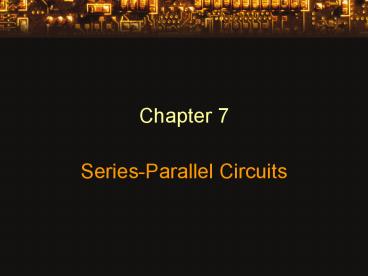SeriesParallel Circuits - PowerPoint PPT Presentation
1 / 20
Title:
SeriesParallel Circuits
Description:
Potentiometers. An example of a variable resistor used as a potentiometer is the volume ... Potentiometers. If a load is added to the circuit, VBC changes. ... – PowerPoint PPT presentation
Number of Views:322
Avg rating:3.0/5.0
Title: SeriesParallel Circuits
1
Chapter 7
- Series-Parallel Circuits
2
The Series-Parallel Network
- A branch is any part of a circuit that can be
simplified as having two terminals. - The components between these two terminals may be
any combination of resistors, voltage sources, or
other elements. - Many complex circuits may be separated into a
combination of both series and/or parallel
elements. - Other circuits consist of combinations which are
neither series nor parallel.
3
The Series-Parallel Network
- To analyze a circuit, you must first recognize
which elements are in series and which are in
parallel. - In this circuit, R2, R3, and R4 are in parallel.
- This combination is in series with R1 and R5.
4
The Series-Parallel Network
- In the circuit shown, R3 and R4 are in parallel.
- This combination is in series with R2.
- The entire combination is in parallel with R1.
5
Analysis of Series-Parallel Circuits
- The rules for analyzing series and parallel
circuits still apply. - The same current occurs through all series
elements. - The same voltage occurs across all parallel
elements. - KVL and KCL apply for all circuits, whether they
are series, parallel, or series-parallel.
6
Analysis of Series-Parallel Circuits
- Redraw complicated circuits showing the source at
the left-hand side. - Label all nodes.
- Develop a strategy. It is usually best to begin
the analysis with the components most distant
from the source. - Simplify recognizable combinations of components.
7
Analysis of Series-Parallel Circuits
- Determine the equivalent resistance RT.
- Solve for the total current.
- Label the polarities of voltage drops on all
components. - Calculate how currents and voltages split between
elements in a circuit. - Verify your answer by taking a different approach.
8
Analysis of Series-Parallel Circuits
- By putting R2 and R3 in parallel, the circuit
reduces to a series circuit. - Use the Voltage Divider Rule to determine Vab and
Vbc. - Calculate all currents from Ohms Law.
9
Analysis of Series-Parallel Circuits
- To find the voltage Vab, first redraw the circuit
in a more simple form. - The original circuit consists of two parallel
branches.
10
Analysis of Series-Parallel Circuits
- Vab may be determined from a combination of the
voltages across R1 and R2. - Use the Voltage Divider Rule to find these two
voltages. - Use KVL to find Vab.
11
Analysis of Series-Parallel Circuits
- To find the currents in the circuit, first redraw
the circuit. - Move the source branch all the way to the left.
- Reduce the circuit to a series circuit..
12
Analysis of Series-Parallel Circuits
- Use the Voltage Divider Rule to determine
voltages. - Use Ohms Law to determine the currents.
13
Bridge Circuit
- Suppose the circuit has Rx 15 k?.
- We want to determine Vab.
- Redraw the circuit as shown on the next slide.
14
Bridge Circuit
- Use the voltage divider to determine Va and Vb.
- Vab 2.5 V.
15
Bridge Circuit
- Suppose Rx is a short circuit (0 ?).
- Determine VR1 by the Voltage Divider Rule.
- VR2 10 V.
- Vab 8 V.
16
Bridge Circuit
- Suppose Rx is an open.
- Find VR1.
- VR2 0 V (No current flow).
- Vab -2 V.
17
Transistor Circuit
- A transistor is a device that amplifies a signal.
- The operating point of a transistor circuit is
determined by a dc voltage source. - We will determine some dc voltages and currents.
18
Transistor Circuit
- Apply KVL
- VBB RBIB VBE REIE
- Using IE 100IB, we find IB 14.3 ?A.
- All other voltages and currents can be determined.
19
Potentiometers
- An example of a variable resistor used as a
potentiometer is the volume control on a
receiver. - When the moveable terminal is at the uppermost
position, VBC 60 V. - At the lowermost position, VBC 0 V.
20
Potentiometers
- If a load is added to the circuit, VBC changes.
- At the upper position, VBC 40 V.
- At the lower position, VBC 0 V.































